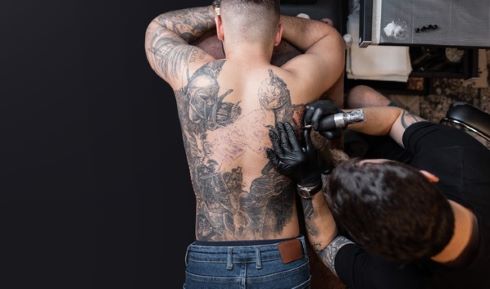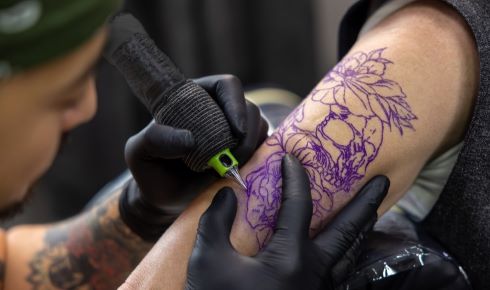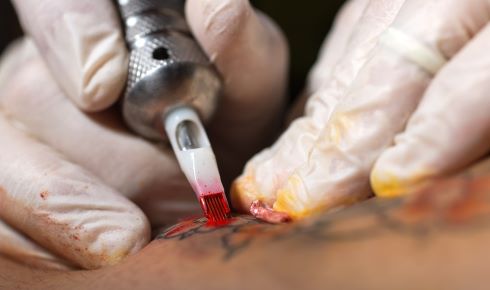The science of body art

21 February 2025
Former microbiologist and public health expert Julie Russell explains how her decades-long career is helping her in a very different role – as the co-owner of a tattoo and piercing studio
Nobody really knows why a young man was murdered in the Tirolean Ötzal Alps on the Austrian/Italian border about 5,300 years ago. But the body of ‘Ötzi the Iceman’, discovered by a German tourist in 1991, has provided valuable insights into what human life was like back then, long before the Neolithic Britons built Stonehenge. One such insight was that tattooing is an extremely ancient practice: Ötzi was adorned with no fewer than 61 tattoos.
No longer the preserve of sailors, bikers and prisoners, it’s estimated that more than a quarter of adults in the UK now have at least one tattoo, and it’s not uncommon to see famous sports stars or musicians with as many tattoos as Ötzi. The perception that having visible tattoos is ‘unprofessional’ is largely outdated, with people across the social spectrum, including royalty, choosing to be inked – Princess Eugenie’s is placed subtly behind her left ear.
 Otzi the Iceman had 61 tattoos. Image courtesy of South Tyrol Museum of Archaeology/Eurac/Samadelli/Staschitz.
Otzi the Iceman had 61 tattoos. Image courtesy of South Tyrol Museum of Archaeology/Eurac/Samadelli/Staschitz.
I had my first tattoo when I was a young microbiologist and a motorcycle enthusiast in the 1990s. My friend and fellow biker, now known as ‘London Dave’, wanted to become a tattooist; he needed someone to help him practise so I volunteered and he tattooed a bird on my back. My most recent tattoo was a microscope on my leg, a tribute to my happy years as a laboratory scientist (and by another friend, Tom, who needed volunteers).
I worked in public health for many years, advising on quality assurance in laboratory test procedures, most recently as Public Health England’s head of culture collections. A key component of a quality system is checking and signing off each test stage. So, it seemed right, when my son reached 18, that I should have him ‘sign me off’ as a competent mum. His signature is tattooed on my foot.
I developed an interest in the art form over many years, and when Tom, who was then eager to learn to tattoo, and I met master tattoo artist Victor RocMed in 2022, we decided to join forces and last year opened a tattoo and piercing studio – the Old Marine Arts Group in north London. As well as enjoying my new artistic vocation, I’ve been delighted to be able to put my public health knowledge into practice – the Old Marine Arts Group is probably the only tattoo studio in the UK with a resident microbiologist.
Under the skin
Tattoo artists use solid needles to puncture the skin thousands of times to introduce pigments into the second layer of the skin, the dermis, to create a permanent design. The outer layer, the epidermis, is shed so often that any ink particles left there will slough off within three to four weeks as the densely packed epithelial cells rise up the layer, die and flake off.
 It is estimated that more than a quarter of UK adults have a tattoo
It is estimated that more than a quarter of UK adults have a tattoo
It is believed that the drop of ink is actually pulled deep into the skin by a vacuum as the needle withdraws from the hole it has made. The dermis is made up of vascularised, irregular connective tissue, and ink particles can either remain trapped between collagen fibres or be taken up by fibrocytes, the cells that make collagen and help repair connective tissue. Macrophages swarm to the area of trauma, attempting to engulf any ink, bacteria, debris and ink-containing cells to break them down. It is believed that when macrophages cannot break down the ink, they instead opt to contain it, essentially encasing the ink within the dense connective tissue. Some ink is taken away into the blood or lymphatic system both immediately and over time, and researchers exploring the safety of tattoo ink have found traces of the pigments in the lymph nodes of people with tattoos¹.
From ink to infection
The skin is home to a complex ecosystem of hundreds of billions of microbial cells and each person’s skin microbiome is unique. It includes normally harmless bacteria and pathogens that can cause infections. Some skin microorganisms are semi-permanent guests, while others are more transient, such as those sprayed by people coughing and sneezing near us or ones we pick up on our hands.
Tattooing creates an open wound that disrupts the skin’s natural barrier, exposing the dermis to potential pathogens as well as the foreign pigments. Some scientific studies indicate that the skin’s microbiome may take weeks to rebalance after tattooing, depending on factors such as the individual’s general and skin health, and aftercare practices². Common bacterial species such as Staphylococcus aureus and Pseudomonas aeruginosa can exploit the disruption and cause infection if a tattoo artist fails to use proper disinfecting procedures³. Even typically benign bacterial species such as Staphylococcus epidermidis and some Corynebacterium species can cause infections when introduced into punctured skin. They can involve dangerous methicillin-resistant S. aureus (MRSA) strains, which are more challenging to treat. Streptococcus pyogenes, infamous as ‘the flesh-eating bug’, has also been associated with tattoo-related skin infections.
Although many tattoo studios follow rigorous hygiene standards³, the risk of infection is heightened further if people ignore the aftercare advice by removing the protective coverings, rubbing inappropriate emollients into their skin or even, as we have heard, allowing their dogs to lick their freshly tattooed skin.
Microorganisms can also be introduced via non-sterile needles, inks, ink diluents and other materials used for tattooing⁴. Localised infections usually manifest as inflammation, with redness, swelling and pain. Untreated infections can lead to cellulitis or abscess formation, and although systemic infections are rare they can occur when bacteria enter the bloodstream, causing sepsis.
However, it is estimated just 5% of tattoos lead to infection⁵. Adherence to proper sterilisation protocols, such as using autoclaves for reusable equipment, and appropriate skin and surface disinfectants, is critical for infection prevention. Artists should decant ink into single-use cups using aseptic techniques that are not unlike those used in a biology laboratory.
Permanent pigments
Tattoo inks normally comprise pigment particles and a carrier solution, such as water, alcohol or glycerin, to help improve solubility and viscosity. Some also contain anti-inflammatory agents to reduce irritation. Traditionally, tattoo inks contained metals such as mercury (red), chromium or copper (green) and white (lead), but modern-day inks are based largely on organic pigments. Numerous studies have shown that the composition of tattoo ink can be variable and microbiological studies have proved that not all inks are sterile at the point of sale⁴.
An emerging trend is for memorial tattoos where the ashes of loved ones (including pets) are mixed with the tattoo ink, although it’s almost impossible to do this and maintain good hygienic practices. Analysis of Ötzi the Iceman’s tattoos suggest they were created by rubbing pigments of fireside ash or soot into small incisions or punctures, so the idea has a long history.
Tattoo ink can sometimes trigger antibody production. Yellow, red and green inks are more frequently associated with allergic reactions, whereas modern black inks are rarely reported to cause allergies. Inks containing azo dyes should be avoided wherever possible because, although they give bright, vivid colours, there are concerns that they could break down into carcinogens over time.
Red ink is also linked to more chronic reactions such as the development of granulomas, which are lumps that form around foreign objects such as a tiny particle of ink. Some allergic reactions can occur years after tattooing, leading to pruritic lesions around the tattoo, and in rare cases tattoos may trigger the Koebner phenomenon, where new lesions form in existing skin diseases.
Individual risks
Client-specific risk factors, such as pre-existing skin conditions, immunosuppression or a history of allergic reactions, can elevate the risk of complications⁶. Artists should also enquire about infections caused by blood-borne pathogens, including hepatitis B, hepatitis C and HIV, for their protection and that of the client.
Infection rates are much lower than they used to be due to the introduction of professional standards in tattooing, although practices vary globally. In many countries, including the UK, tattoo studios are subject to health regulations, although enforcement varies countrywide.
Public Health England and its partners released guidelines in 2013⁷ to help tattoo studios maintain safe practices that protect the clients and the tattoo artists themselves. Regulatory agencies such as the European Chemicals Agency evaluate tattoo inks for safety, focusing on potential bacterial contamination and the presence of toxic chemicals⁶. Proper hygiene protocols and careful aftercare mitigate the risks, although continued research is needed to fully understand the long-term health effects of tattooing.
 Regulatory agencies evaluate tattoo inks for safety, focusing on bacterial contamination and toxic chemicals
Regulatory agencies evaluate tattoo inks for safety, focusing on bacterial contamination and toxic chemicals
Dispelling myths
There are no scientifically robust descriptions of skin cancer being attributed directly to tattooing⁸, despite tabloid newspaper stories to the contrary. Some older tattoo ink ingredients are known to be carcinogens; those inks are now banned in Europe and some other countries due to an association with cancers elsewhere in the body such as the liver or bladder. Melanomas (skin cancers), which can appear as coloured moles, may be harder to spot on heavily tattooed skin, and it’s possible that in the rare event that granulomas or skin bumps develop around a tattoo, they could obscure the results of some diagnostic tests such as MRI scans.
There’s also no definitive evidence that tattoos can confer health benefits, ‘toughening you up’ and helping to make you resistant to colds, flu or any other infections. Nevertheless, people with healthy immune systems may heal faster, making them more likely to get multiple tattoos⁹.
We can barely imagine the circumstances surrounding Ötzi the Iceman’s 61 primitive tattoos and certainly have no idea about the hygiene conditions. However, we can conclude that tattooing is mostly safe today, with some risks for a small number of people. It’s clear that it’s not only the artistic ability of your tattoo artist that’s important, but also their knowledge of hygiene, and health and safety procedures.
So, choose your tattoo artist carefully, wear your body art proudly, look after it and shield it from the sun – and please don’t let your dog lick your new tattoo! I hope you also find these age-old dermal decorations as fascinating as I do.
1) Schreiver, I. et al. Synchrotron-based ν-XRF mapping and μ-FTIR microscopy enable to look into the fate and effects of tattoo pigments in human skin. Sci. Rep. 7, 11395 (2017). bit.ly/41AFcFR
2) Byrd, A. L. et al. The human skin microbiome. Nat. Rev. Microbiol. 16(3), 143–155 (2018).
3) Kaur, R. R. et al. Tattoos and infection: A review of the literature and comparison of industry infection control practices to current guidelines. Clin. Infect. Dis. 48(1), 1–7 (2009).
4) Yoon, S. et al. Detection of anaerobic and aerobic bacteria from commercial tattoo and permanent makeup inks. Appl. Environ. Microbiol. 90(7) (2024).
5) Contor, L. et al. Safety of tattoos and permanent makeup: Adverse health effects and experience with the Council of Europe Resolution (2008)1. European Commission: Joint Research Centre Publications Office, 2016.
6) Laux, P. et al. A medical-toxicological view of tattooing. The Lancet, 387(10016), 395–402 (2016).
7) PHE supports new tattooing and body piercing guidance. Gov.uk (2013).
8) Does tattoo ink give you cancer? Cancer Council Australia.
9) Lynn, C. D. et al. Tattooing to ‘Toughen up’: Tattoo experience and secretory immunoglobulin A. Am. J. Hum. Biol. 28(5), 603–609 (2016).
Julie Russell is a former head of Public Health England’s culture collections. She is now co-owner of Old Marine Arts Group tattoo studio in London.


